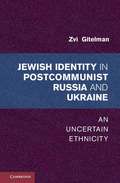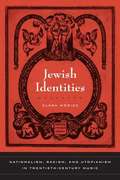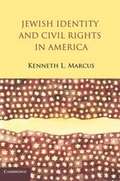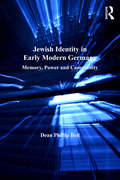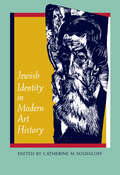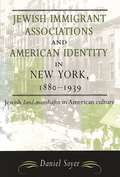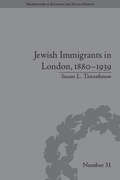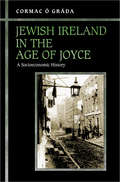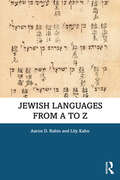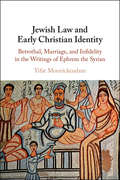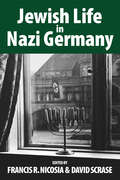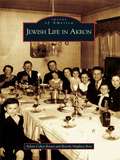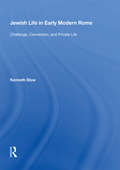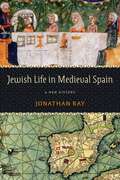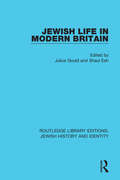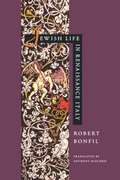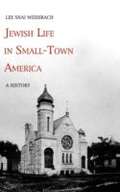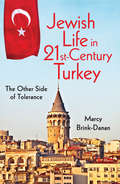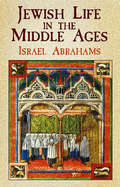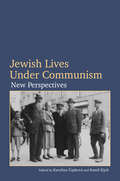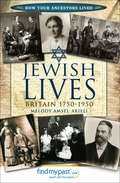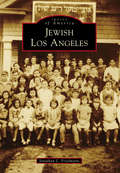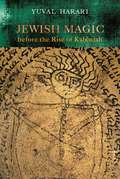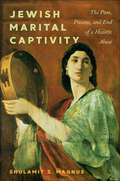- Table View
- List View
Jewish Identities in Postcommunist Russia and Ukraine: An Uncertain Ethnicity
by Zvi GitelmanBefore the USSR collapsed, ethnic identities were imposed by the state. This book analyzes how and why Jews decided what being Jewish meant to them after the state dissolved and describes the historical evolution of Jewish identities. Surveys of more than 6,000 Jews in the early and late 1990s reveal that Russian and Ukrainian Jews have a deep sense of their Jewishness but are uncertain what it means. They see little connection between Judaism and being Jewish. Their attitudes toward Judaism, intermarriage and Jewish nationhood differ dramatically from those of Jews elsewhere. Many think Jews can believe in Christianity and do not condemn marrying non-Jews. This complicates their connections with other Jews, resettlement in Israel, the United States and Germany, and the rebuilding of public Jewish life in Russia and Ukraine. Post-Communist Jews, especially the young, are transforming religious-based practices into ethnic traditions and increasingly manifesting their Jewishness in public.
Jewish Identities: Nationalism, Racism, and Utopianism in Twentieth-Century Music
by Klara MoriczKlara Moricz scrutinizes concepts of Jewish identity and reorders ideas about twentieth-century "Jewish music" in three case studies: first, Russian Jewish composers of the first two decades of the twentieth century; second, the Swiss American Ernest Bloch; and third, Arnold Schoenberg.
Jewish Identity and Civil Rights in America
by Kenneth L. MarcusGiven jurisdiction over race and national origin but not religion, federal agents have had to determine whether Jewish Americans constitute a race or national origin group. They have been unable to do so. This has led to enforcement paralysis, as well as explosive internal confrontations and recriminations within the federal government. This book examines the legal and policy issues behind the ambiguity involved with civil rights protections for Jewish students. Written by a former senior government official, this book reveals the extent of this problem and presents a workable legal solution.
Jewish Identity in Early Modern Germany: Memory, Power and Community
by Dean Phillip BellAlthough Jews in early modern Germany produced little in the way of formal historiography, Jews nevertheless engaged the past for many reasons and in various and surprising ways. They narrated the past in order to enforce order, empower authority, and record the traditions of their communities. In this way, Jews created community structure and projected that structure into the future. But Jews also used the past as a means to contest the marginalization threatened by broader developments in the Christian society in which they lived. As the Reformation threw into relief serious questions about authority and tradition and as Jews continued to suffer from anti-Jewish mentality and politics, narration of the past allowed Jews to re-inscribe themselves in history and contemporary society. Drawing on a wide range of sources, including chronicles, liturgical works, books of customs, memorybooks, biblical commentaries, rabbinic responsa and community ledgers, this study offers a timely reassessment of Jewish community and identity during a frequently turbulent era. It engages, but then redirects, important discussions by historians regarding the nature of time and the construction and role of history and memory in pre-modern Europe and pre-modern Jewish civilization. This book will be of significant value, not only to scholars of Jewish history, but anyone with an interest in the social and cultural aspects of religious history.
Jewish Identity in Modern Art History
by Catherine M. SoussloffIn the first comprehensive study of Jewish identity and its meaning for the history of art, eleven influential scholars illuminate the formative role of Jews as subjects of art historical discourse. At the same time, these essays introduce to art history an understanding of the place of cultural identity in the production of scholarship.Contributors explore the meaning of Jewishness to writers and artists alike through such topics as exile, iconoclasm, and anti-Semitism. Included are essays on Anselm Kiefer and Theodor Adorno; the effects of the Enlightenment; the rise of the nation-state; Nazi policies on art history; the criticism of Meyer Schapiro, Clement Greenberg, and Aby Warburg; the art of Judy Chicago, Eleanor Antin, and Morris Gottlieb; and Jewish patronage of German Expressionist art.Offering a new approach to the history of art in which the cultural identities of the makers and interpreters play a constitutive role, this collection begins an important and overdue dialogue that will have a significant impact on the fields of art history, Jewish studies, and cultural studies.
Jewish Immigrant Associations and American Identity in New York, 1880-1939: Jewish Landsmanshaftn in American Culture (American Jewish Civilization Series)
by Daniel SoyerLandsmanshaftn, associations of immigrants from the same hometown, became the most popular form of organization among Eastern European Jewish immigrants to the United States in the late 19th and early 20th centuries. Jewish Immigrant Associations and American Identity in New York, 1880-1939, by Daniel Soyer, holds an in-depth discussion on the importance of these hometown societies that provided members with valuable material benefits and served as arenas for formal and informal social interaction. In addition to discussing both continuity and transformation as features of the immigrant experience, this approach recognizes that ethnic identity is a socially constructed and malleable phenomenon. Soyer explores this process of construction by raising more specific questions about what immigrants themselves have meant by Americanization and how their hometown associations played an important part in the process.
Jewish Immigrants in London, 1880–1939 (Perspectives in Economic and Social History #31)
by Susan L TananbaumBetween 1880 and 1939, a quarter of a million European Jews settled in England. Tananbaum explores the differing ways in which the existing Anglo-Jewish communities, local government and education and welfare organizations sought to socialize these new arrivals, focusing on the experiences of working-class women and children.
Jewish Internationalism and Human Rights after the Holocaust (Human Rights in History)
by Nathan A. KurzNathan A. Kurz charts the fraught relationship between Jewish internationalism and international rights protection in the second half of the twentieth century. For nearly a century, Jewish lawyers and advocacy groups in Western Europe and the United States had pioneered forms of international rights protection, tying the defense of Jews to norms and rules that aspired to curb the worst behavior of rapacious nation-states. In the wake of the Holocaust and the creation of the State of Israel, however, Jewish activists discovered they could no longer promote the same norms, laws and innovations without fear they could soon apply to the Jewish state. Using previously unexamined sources, Nathan Kurz examines the transformation of Jewish internationalism from an effort to constrain the power of nation-states to one focused on cementing Israel's legitimacy and its status as a haven for refugees from across the Jewish diaspora.
Jewish Ireland in the Age of Joyce: A Socioeconomic History
by Cormac Ó GrádaJames Joyce's Leopold Bloom--the atheistic Everyman of Ulysses, son of a Hungarian Jewish father and an Irish Protestant mother--may have turned the world's literary eyes on Dublin, but those who look to him for history should think again. He could hardly have been a product of the city's bona fide Jewish community, where intermarriage with outsiders was rare and piety was pronounced. In Jewish Ireland in the Age of Joyce, a leading economic historian tells the real story of how Jewish Ireland--and Dublin's Little Jerusalem in particular--made ends meet from the 1870s, when the first Lithuanian Jewish immigrants landed in Dublin, to the late 1940s, just before the community began its dramatic decline. In 1866--the year Bloom was born--Dublin's Jewish population hardly existed, and on the eve of World War I it numbered barely three thousand. But this small group of people quickly found an economic niche in an era of depression, and developed a surprisingly vibrant web of institutions. In a richly detailed, elegantly written blend of historical, economic, and demographic analysis, Cormac Ó Gráda examines the challenges this community faced. He asks how its patterns of child rearing, schooling, and cultural and religious behavior influenced its marital, fertility, and infant-mortality rates. He argues that the community's small size shaped its occupational profile and influenced its acculturation; it also compromised its viability in the long run. Jewish Ireland in the Age of Joyce presents a fascinating portrait of a group of people in an unlikely location who, though small in number, comprised Ireland's most resilient immigrant community until the Celtic Tiger's immigration surge of the 1990s.
Jewish Languages from A to Z
by Lily Kahn Aaron D. RubinJewish Languages from A to Z provides an engaging and enjoyable overview of the rich variety of languages spoken and written by Jews over the past three thousand years. The book covers more than 50 different languages and language varieties. These include not only well-known Jewish languages like Hebrew, Yiddish, and Ladino, but also more exotic languages like Chinese, Esperanto, Malayalam, and Zulu, all of which have a fascinating Jewish story to be told. Each chapter presents the special features of the language variety in question, a discussion of the history of the associated Jewish community, and some examples of literature and other texts produced in it. The book thus takes readers on a stimulating voyage around the Jewish world, from ancient Babylonia to 21st-century New York, via such diverse locations as Tajikistan, South Africa, and the Caribbean. The chapters are accompanied by numerous full-colour photographs of the literary treasures produced by Jewish language-speaking communities, from ancient stone inscriptions to medieval illuminated manuscripts to contemporary novels and newspapers. This comprehensive survey of Jewish languages is designed to be accessible to all readers with an interest in languages or history, regardless of their background—no prior knowledge of linguistics or Jewish history is assumed.
Jewish Law and Early Christian Identity: Betrothal, Marriage, and Infidelity in the Writings of Ephrem the Syrian
by Yifat MonnickendamEphrem, one of the earliest Syriac Christian writers, lived on the eastern outskirts of the Roman Empire during the fourth century. Although he wrote polemical works against Jews and pagans, and identified with post-Nicene Christianity, his writings are also replete with parallels with Jewish traditions and he is the leading figure in an ongoing debate about the Jewish character of Syriac Christianity. This book focuses on early ideas about betrothal, marriage, and sexual relations, including their theological and legal implications, and positions Ephrem at a precise intersection between his Semitic origin and his Christian commitment. Alongside his adoption of customs and legal stances drawn from his Greco-Roman and Christian surroundings, Ephrem sometimes reveals unique legal concepts which are closer to early Palestinian, sectarian positions than to the Roman or Jewish worlds. The book therefore explains naturalistic legal thought in Christian literature and sheds light on the rise of Syriac Christianity.
Jewish Life In Nazi Germany
by Francis R. Nicosia David ScraseGerman Jews faced harsh dilemmas in their responses to Nazi persecution, partly a result of Nazi cruelty and brutality but also a result of an understanding of their history and rightful place in Germany. This volume addresses the impact of the anti-Jewish policies of Hitler's regime on Jewish family life, Jewish women, and the existence of Jewish organizations and institutions and considers some of the Jewish responses to Nazi anti-Semitism and persecution. This volume offers scholars, students, and interested readers a highly accessible but focused introduction to Jewish life under National Socialism, the often painful dilemmas that it produced, and the varied Jewish responses to those dilemmas.
Jewish Life in Akron (Images of America)
by Beverly Magilavy Rose Arlene Cohen RossenIn the mid-1800s, many Jewish families joined the western expansion and emigrated from Germany to Akron, a canal town that also had an inviting countryside. They sought economic security and religious freedom--a new start in a new town. But it was not an easy life. They organized their Jewish community into cultural and religious groups, and by the 20th century, their efforts attracted Central and Eastern European Jews with differing lifestyles. In 1929, the Akron Jewish Center opened and provided a place for all of the diverse Jewish groups in Akron to gather. It also played an enormous role in raising awareness of the richness of Jewish life in the Akron community. Jewish Life in Akron celebrates 150 years of Jewish culture, family, business, and organizational life through vintage images, many never before published, and supporting history.
Jewish Life in Early Modern Rome: Challenge, Conversion, and Private Life
by Kenneth StowThe essays in this second volume by Kenneth Stow explore the fate of Jews living in Rome, directly under the eye of the Pope. Most Roman Jews were not immigrants; some had been there before the time of Christ. Nor were they cultural strangers. They spoke (Roman) Italian, ate and dressed as did other Romans, and their marital practices reflected Roman noble usage. Rome's Jews were called cives, but unequal ones, and to resolve this anomaly, Paul IV closed them within ghetto walls in 1555; the rest of Europe would resolve this crux in the late eighteenth century, through civil Emancipation. In its essence, the ghetto was a limbo, from which only conversion, promoted through "disciplining" par excellence, offered an exit. Nonetheless, though increasingly impoverished, Rome's Jews preserved culture and reinforced family life, even many women's rights. A system of consensual arbitration enabled a modicum of self-governance. Yet Rome's Jews also came to realize that they had been expelled into the ghetto: nostro ghet, a document of divorce, as they called it. There they would remain, segregated, so long as they remained Jews. Such are the themes that the author examines in these essays.
Jewish Life in Medieval Spain: A New History (Jewish Culture and Contexts)
by Jonathan RayJewish Life in Medieval Spain is a detailed exploration of the Jewish experience in medieval Spain from the dawn of Sephardic society in the ninth century to the expulsion of 1492. An important contribution of the book is the integration of the rise and fall of Jewish life in Muslim al-Andalus into the history of the Jews in medieval Christian Spain. It traces the collapse of Jewish life in Muslim Spain, the emigration of Andalusi Jewry to the lands of Christian Iberia, and the long and difficult confluence of these two distinct Jewish subcultures.Focusing on internal developments of Jewish society, it offers a narrative of Jewish history from the inside out, bringing to light the various divisions and rivalries within the Jewish community. This approach, in turn, allows for a deeper understanding of the complex relations between Spanish Jews and their Muslim and Christian neighbors. Jonathan Ray’s original perspective on the Jewish experience is particularly instructive when considering the widescale anti-Jewish riots of 1391. The combination of violence and mass conversion of the Jews irrevocably shifted the dynamics of inter-religious relations as well as those within the Jewish community itself. Yet even in the wake of these tragic events, the Jews of Spain continued to flourish, fostering a culture that they would carry into exile and that would preserve the memory of Jewish Spain for centuries to come.
Jewish Life in Modern Britain (Routledge Library Editions: Jewish History and Identity)
by Julius Gould and Shaul EshOriginally published in 1964, this volume aims to convey global perspectives on the Jewish situation in the late 20th Century by discussing research in Jewish social structure and social problems. Historians and social scientists from around the world contributed to the volume to discuss subjects as diverse as oral history, communal organizing and Jewish education.
Jewish Life in Renaissance Italy
by Robert Bonfil Anthony OldcornWith this heady exploration of time and space, rumors and silence, colors, tastes, and ideas, Robert Bonfil recreates the richness of Jewish life in Renaissance Italy. He also forces us to rethink conventional interpretations of the period, which feature terms like "assimilation" and "acculturation. " Questioning the Italians' presumed capacity for tolerance and civility, he points out that Jews were frequently uprooted and persecuted, and where stable communities did grow up, it was because the hostility of the Christian population had somehow been overcome. After the ghetto was imposed in Venice, Rome, and other Italian cities, Jewish settlement became more concentrated. Bonfil claims that the ghetto experience did more to intensify Jewish self-perception in early modern Europe than the supposed acculturation of the Renaissance. He shows how, paradoxically, ghetto living opened and transformed Jewish culture, hastening secularization and modernization. Bonfil's detailed picture reveals in the Italian Jews a sensitivity and self-awareness that took into account every aspect of the larger society. His inside view of a culture flourishing under stress enables us to understand how identity is perceived through constant interplay--on whatever terms--with the Other.
Jewish Life in Small-Town America: A History
by Lee Shai WeissbachLee Shai Weissbach offers the first comprehensive portrait of small-town Jewish life in America. Exploring the history of communities of 100 to 1000 Jews, the book focuses on the years from the mid-nineteenth century to World War II. Weissbach examines the dynamics of 490 communities across the United States and reveals that smaller Jewish centers were not simply miniature versions of larger communities but were instead alternative kinds of communities in many respects. The book investigates topics ranging from migration patterns to occupational choices, from Jewish education and marriage strategies to congregational organization. The story of smaller Jewish communities attests to the richness and complexity of American Jewish history and also serves to remind us of the diversity of small-town society in times past.
Jewish Life in Twenty-First-Century Turkey
by Marcy Brink-DananTurkey is famed for a history of tolerance toward minorities, and there is a growing nostalgia for the "Ottoman mosaic." In this richly detailed study, Marcy Brink-Danan examines what it means for Jews to live as a tolerated minority in contemporary Istanbul. Often portrayed as the "good minority," Jews in Turkey celebrate their long history in the region, yet they are subject to discrimination and their institutions are regularly threatened and periodically attacked. Brink-Danan explores the contradictions and gaps in the popular ideology of Turkey as a land of tolerance, describing how Turkish Jews manage the tensions between cosmopolitanism and patriotism, difference as Jews and sameness as Turkish citizens, tolerance and violence.
Jewish Life in the Middle Ages
by Israel AbrahamsHighly readable social history comprehensively examines life of European Jews, from approximately the late 10th-century to the early 1500s. Topics include social functions of the synagogue, communal organizations, love, courtship and marriage, monogamy and home life, trades and occupations, medieval pastimes and personal relations between Christians and Jews.
Jewish Lives Under Communism: New Perspectives
by David Shneer Gennady Estraikh Anna Shternshis Diana Dumitru Katerina Capková Kamil Kijek Stephan Stach Valery Dymshits Anna Koch Agata Maksimowska Marcos Silber Galina Zelenina Kata BohusThis volume provides new, groundbreaking views of Jewish life in various countries of the pro-Soviet bloc from the end of the Second World War until the collapse of Communism in late 1989. The authors, twelve leading historians and anthropologists from Europe, Israel and the United States, look at the experience of Jews under Communism by digging beyond formal state policy and instead examining the ways in which Jews creatively seized opportunities to develop and express their identities, religious and secular, even under great duress. The volume shifts the focus from Jews being objects of Communist state policy (and from anti-Jewish prejudices in Communist societies) to the agency of Jews and their creativity in Communist Europe after the Holocaust. The examination of Jewish history from a transnational vantage point challenges a dominant strand in history writing today, by showing instead the wide variety of Jewish experiences in law, traditions and institutional frameworks as conceived from one Communist country to another and even within a single country, such as Poland, Czechoslovakia, Hungary, East Germany, and the Soviet Union. By focusing on networks across east-central Europe and beyond and on the forms of identity open to Jews in this important period, the volume begins a crucial rethinking of social and cultural life under Communist regimes.
Jewish Lives: Britain 1750–1950 (How Your Ancestors Lived)
by Melody Amsel-Arieli&“Offers a guide to family historians who want to reconstruct their family trees. Invaluable . . . to other Jews in search of their roots&” (Jewish Renaissance). Jewish Lives presents the life-stories of ten individual Jews who immigrated to Britain between 1750 and 1950, based on actual genealogical research. Their stories, enriched by a variety of sources, reflect the experiences of all Jewish immigrants as they settled in their adopted land. Melody Amsel-Arieli does not just piece together the detail of their lives—their work, pastimes, families, daily chores, food, and celebrations. Drawing on social, economic, and historical records, she also explores their background, places of origin, motives for immigration, arrival in the United Kingdom, and experiences as they adjusted to their new surroundings—placing them in the wider historical context of their adopted community and society. This selection of revealing life-stories will prove fascinating for family historians and researchers, Jewish and non-Jewish alike, by offering parallels with their own lives and the lives of their ancestors. Jewish Lives: Britain 1750–1950 will inspire readers to pursue their own quest for information and understanding of their pasts. &“Each tale is based on research shared by a descendent, so sources very from official documents to diaries and memories, adding a rich, personal dimension.&” —Family Tree &“Melody Amsel-Arieli is a prolific writer on matters genealogical and historical, but in this book her expertise in both fields shines out. For anyone researching his or her own immigrant family, Jewish Lives really is a must-read.&” —Who Do You Think You Are?
Jewish Los Angeles: Jewish Musicians In Los Angeles, 1887-1927 (Images of America)
by Jonathan L. FriedmannThe first known Jewish resident of the Mexican Pueblo de Los Ángeles arrived in 1841. When California entered the Union in 1850, the census listed just eight Jews living in Los Angeles. By 1855, the fledgling city had a Hebrew Benevolent Society and a Jewish cemetery. The first Jewish congregation and kosher market were established in 1862. Meanwhile, Jewish merchants and business owners founded banks, fraternal orders, charities, athletic clubs, and social service organizations. Jewish property owners developed vast areas of Los Angeles and beyond into the neighborhoods and cities we know today. By 1897, the city's Jewish population was large enough to support its own newspaper. The 20th century brought waves of Jewish immigrants and migrants to Los Angeles, where they built the motion picture and television industries, Cedars-Sinai and City of Hope medical centers, the Jewish Home for the Aging, urban and suburban synagogues and Jewish centers, and other institutions. The foundations laid by these enterprising pioneers helped transform Los Angeles into a major metropolis.
Jewish Magic before the Rise of Kabbalah (Raphael Patai Series in Jewish Folklore and Anthropology)
by Yuval Harari“Magic culture is certainly fascinating. But what is it? What, in fact, are magic writings, magic artifacts?” Originally published in Hebrew in 2010, Jewish Magic Before the Rise of Kabbalah is a comprehensive study of early Jewish magic focusing on three major topics: Jewish magic inventiveness, the conflict with the culture it reflects, and the scientific study of both. The first part of the book analyzes the essence of magic in general and Jewish magic in particular. The book begins with theories addressing the relationship of magic and religion in fields like comparative study of religion, sociology of religion, history, and cultural anthropology, and considers the implications of the paradigm shift in the interdisciplinary understanding of magic for the study of Jewish magic. The second part of the book focuses on Jewish magic culture in late antiquity and in the early Islamic period. This section highlights the artifacts left behind by the magic practitioners—amulets, bowls, precious stones, and human skulls—as well as manuals that include hundreds of recipes. Jewish Magic before the Rise of Kabbalah also reports on the culture that is reflected in the magic evidence from the perspective of external non-magic contemporary Jewish sources. Issues of magic and religion, magical mysticism, and magic and social power are dealt with in length in this thorough investigation. Scholars interested in early Jewish history and comparative religions will find great value in this text.
Jewish Marital Captivity: The Past, Present, and End of a Historic Abuse
by Shulamit S. MagnusSolutions to divorce abuse in Jewish societiesJewish Marital Captivity centers on the experience of women encountering systemic disadvantage in rabbinic marriage and divorce throughout Jewish history and across the map of Jewish life. In rabbinic law, marriage is a unilateral act by the husband, making divorce, similarly, the husband’s sole prerogative, in which his conscious will is also sacrosanct. Abuse necessarily follows, and has been the case from earliest recorded history when husbands abandoned wives, perished on business trips or in war or criminal incidents, or maliciously refused wives a rabbinic writ of divorce (get), or extorted for one, leaving wives trapped in marriage, including to dead men. There is no time limit to this state. Women in such marital captivity, without a husband’s economic partnership, or divorce or death settlements, yet unfree to contract other marriages, suffered devastating social, economic, and psychological hardship, as did their children. Women’s marital captivity has been treated as an issue in rabbinic law but has not, until now, been studied as a problem in Jewish societies across time and place, with a focus on the predicament and behavior of women.Jewish Marital Captivity is a social history of this problem from the seventh century to the present across multiple Jewish communities, focusing on the interaction of law and social reality. Magnus documents a pattern of assertive and transgressive actions by pious and rebellious women in traditional Jewish societies to escape marital captivity, often, with the assistance of male kin, also probing why such behavior emerged in pre-modern, patriarchal societies. She charts women’s role in the emergence of reforms in the medieval era offering women significant protections in marriage and divorce, and rabbinic backlash against these advances. This backlash was codified and its legal rulings are enacted to this day in rabbinic courts in the US and other Diaspora communities and in Israel, which lacks civil marriage and divorce and where Jewish citizens can only get divorced in rabbinic courts. It combines a sweeping history of Jewish women’s marital captivity with an analysis of the problem’s systemic nature, however personally and individually women experience it, and with a critique of current policy as seeking to manage and thus, perpetuate, rather than end the abuse. It applies the lessons of the history uncovered to propose solutions to what Magnus presents not as an Orthodox or an Israeli problem, but a Jewish one.
